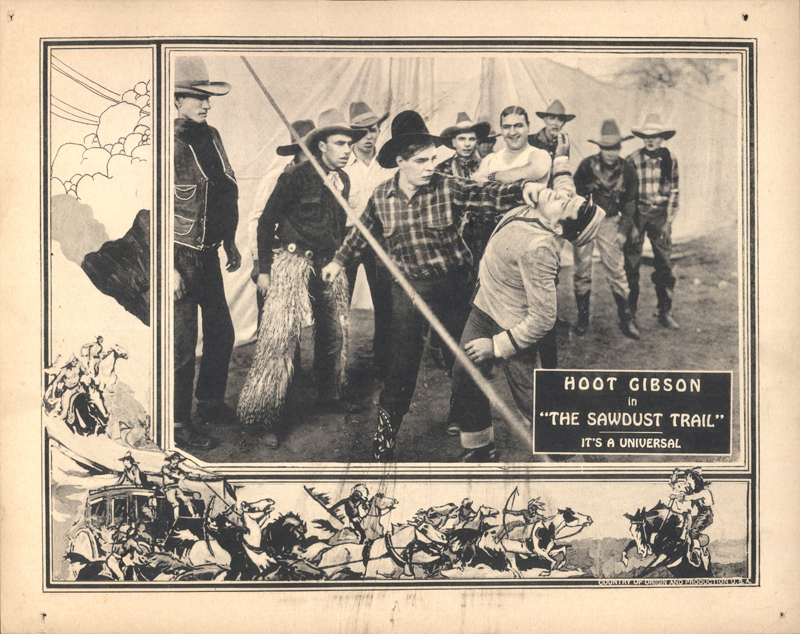Popular Western actor and future Saugus rodeo owner Hoot Gibson (center, throwing punch) stars in "The Sawdust Trail," produced by Gibson (as Hoot
Gibson Productions) for Universal release in 1924.
We don't know where this film was shot, and it doesn't appear to have been released on video. Apparently the film still exists, because the television programming
data provider Rovi has published a plot summary for it. (An estimated 82 percent of all silent films are lost.)
From Hans J. Wollstein at Rovi: "Universal's top Western ace Hoot Gibson enjoyed fine support from another of the studio's sagebrush stars
— cowgirl Josie Sedgwick — in this average silent oater. He is a college boy from the East who joins a Wild West show, she the man-hating
Calamity Jane, victim of a series of practical jokes. Played for laughs despite the participation of veteran bad guy G. Raymond Nye,
'Sawdust Trail' was typical Gibson fare and vastly popular with less-discriminating audiences."
The term "sawdust trail" originated with traveling ministers who staged revival meetings, usually in tents with sawdust covering the dirt floor. Participants
who came forward to be converted by the preacher were said to "hit the sawdust trail" when they came up the center aisle. Later, the term was expanded to include
traveling Wild West shows and circuses; performers left home and hit the sawdust trail. Note the tent in the photo on this lobby card.
This "Sawdust Trail" was based on a story by William Dudley Pelley called "Courtin' Calamity," dealing with the aforementioned Calamity Jane and published
in the Saturday Evening Post. Pelley (March 12, 1890 - June 30, 1965) was an accomplished journalist but took a turn in the late 1910s when he covered the Russian Civil War, which pitted czarist White Russians
(backed by pro-German armies) against the Bolshevik Red Army. It was here that Pelley developed (or honed) a hatred for communists and Jews, convinced they wanted to
take over the world. He returned to the states in 1920 and worked in Hollywood but grew disillusioned and left for North Carolina soon after
1928, when he claimed to have met God and Jesus Christ. He said they taught him to levitate and instructed him to lead a spiritual awakening. The 1933 election of Adolf Hitler
as German chancellor inspired him to form the Silver League, an anti-Semitic and nominally Christian extremist organization complete with silver uniforms
and a scarlet "L" for an emblem. Pelley ran for U.S. President on the Christian Party ticket in 1936 and, while singing Hitler's praises,
accused Roosevelt of being a warmonger. He disbanded the Silver League after the Japanese attack on Pearl Harbor but kept up his rhetoric,
which landed him in hot water with the House Un-American Activities Committee.
(The committee targeted
Nazi sympathizers during World War II; not until about 1947 did it start going after communist sympathizers.) Pelley was arrested in Indiana in 1942 and sentenced to 15 years for high treason
and other charges.
He made parole in 1952 and died in 1965.
Back to our movie. Pelley shares story credit with Richard Schayer, adaptation by
Raymond L. Schrock. Director is Edward Sedgwick; presenter and executive producer is Carl Laemmle (Pelley must have been beside himself); cinematography by Virgil Miller.
Joining Gibson, Nye and Josie Sedgwick (the director's sister) on screen are David Torrence,
Charles K. French,
Harry Todd,
Pat Harmon,
Taylor Carroll and
W.T. McCulley.
Edmund Richard Gibson earned the nickname "Hoot" when he worked as a messenger for the Owl Drug Co.
He was born August 6, 1892, in Tekamah, Nebraska and appeared in more than 200 films (including short
features) between 1910, when he earned $50 for his role in "The Two Brothers," and
1960, when he made an uncredited appearance in "Ocean's Eleven." Gibson did
most of his work as a silent cowboy actor between World War I and the early 1930s. He directed a bit
in 1920-21 and produced some of his own films from 1923-30. The 5'9" Hollywood giant died of
cancer on August 23, 1962, in Woodland Hills — five days before a wildfire burned down
Gene Autry's Melody Ranch in Placerita Canyon, where Gibson made some of his movies.
In addition to using the Santa Clarita Valley as a backdrop for filming, during the time he was
married to Dorothea Sally Eilers (a popular leading lady in late
silents and early talkies), he owned a ranch in Saugus now known as the Saugus Speedway. SCV historian
Jerry Reynolds writes:
"Roy Baker purchased a 40-acre tract east of Bouquet Junction during 1923, starting construction on
a rodeo arena a year later. Hoot Gibson bought the ranch and stadium in 1930, putting on shows that attracted
such stars as Tom Mix, John Wayne and Clark Gable. In 1934 Gibson sold out to Paul Hill, who ran the
Western Livestock yards and leased it to film companies for three years until a huge flood filled the home
and arena with mud and debris. (Hill) was unable to make payments, and the bank repossessed the property,
which was eventually taken over by a professor of economics at Occidental College, William Bonelli (who
started the Santa Clarita Water Co. and built one of the first local housing tracts in the late 1940s).
Today (the rodeo arena) is known as the Saugus Speedway."









